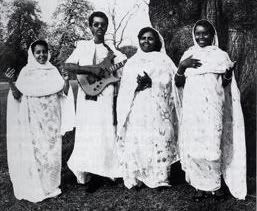
Anyone who's heard (the sadly out-of-print) Moorish Music of Mauritania (1990) by Dimi Mint Abba and Khalifa Ould Eide can attest to the marvelous music contained within.
The highlight: her trademark vocals--strikingly hoarse yet as nimble and graceful as you can imagine, easily gliding over top of the craggiest of melodic terrain (full of tic-like ornaments and flickering appregiations).
As the anthropological title suggests, the record is relatively traditional and largely acoustic featuring percussion (tabl), qawwali-esque clapping and group vocals, the four-stringed tidnit, the buzzing harp (ardia) and electric guitar. It was recorded, however, in the studio and not "the field".
The songs reference her griot(te) roots, as well as devotional themes but incorporate some more modern elements. It could be considered the culmination of her worldwide exposure, which spread across all of Africa and the Arab world (in 1976 she won a Gold Medal at the Oum Kolthoum Festival in Tunisia for her vocal talents!) , to Europe and then elsewhere.
Then there's also the equally brilliant singer Ouleya Mint Amartichitt, who, hot on the heels of the aforementioned album also managed to make a bit of splash in the World Music industry with her album Praise Songs, now also out-of-print (and also fetching similarly exhorbitant approaching-three-digit prices in Amazon's marketplace).
Both artists were embraced early on by the then-young World-Music machine, (seemingly looking for the next "big" thing). Now a few years on, you'll have to look to music forums, blogs and Youtube to get a hold of their music.
When I was poking around on Youtube though I caught some interesting glimpses into the less- Westernized (in terms of its production and target audience) yet, not necessarily more traditional stuff that also goes on in Mauritania. I decided to look around more and share some of my findings.
Here's a few from Dimi...
This one is notable for the absense of percussive rhythmic drive, but for the presence of the woozy psychedelia emanating from the guitars and synths. Note the guitar player's built-in effects!
Here's a guitar solo from the same excerpt. Who the hell said phasers are over? Awesome!
Here's what looks like an old-school clip of Dimi...
Now on to Ouleya Mint Amartichitt
Here's a video from singer Enima Mint Sheik.
Here is another singer whose name I am not sure of. She has a smoother less fiery voice than her peers but still gracefully executes the rapid melismas.
Another...
ida3t mauritane musique
Uploaded by aitoussya
Here's two real old ones by Hadrami Ould El Meydah:
Enjoy! And if you have any tips on the singers, or any links to downloads of this music (or spots for purchasing it) feel free to comment!

